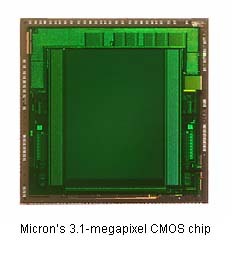Micron releases high-res CMOS image sensors for cellphones
Boise (ID) - Chip manufacturer Micron today announced two new CMOS-based image sensors that promise to increase the quality of images taken with camera phones and entry-level digital still cameras (DSCs). For the first time, camera phone pictures could reach a quality level that justifies spending money for an actual print of such snapshots.
If we believe the research from the analyst crowd, then more than 190 million Americans own a cellphone - with most of us currently owning or soon be using a device that integrates a camera. Despite all that market penetration and marketing hype, these cameras are of little use for a world outside of multimedia messaging. Even the new megapixel generation will not deliver the quality in pictures we would expect to be sufficient for a decent 4x6 or 5x7 print.
The reason for this current scenario is the technology behind cameras for phones. Its not just megapixel that plays into the quality of an image, there are many other factors such as optics or the sensor chip that influence the outcome. For example, while typical DSCs rely on CCDs to capture images, cellphones use CMOS chips - which pack camera functionality into a much smaller form factor, use less power, and are cheaper to manufacture, but generally deliver not the picture quality of CCDs.
"Micron's new 5-megapixel and 3.1-megapixel image sensors really take CMOS imagers to the next level," stated Hisayuki Suzuki, senior director of marketing for Micron. "The image quality and resolution of these new sensors will challenge the dominance of CCD technology in the high-volume, point-and-shoot segment of the DSC market and will also bring DSC-class images to the lucrative camera phone market."
According to Vern Klein, director of business development for the Micron Imaging Group, users' perceptions about camera phones are changing: "Users are asking for much more quality pictures from a camera phone," he told Tom's Hardware Guide. "Users are expecting good quality images under all conditions."
The challenge for CMOS image sensor manufacturer, however, is that cellphone manufacturers prioritize on other factors than image quality in image sensors. "Sensor chips are mainly constrained by the factors of size and cost. Every chip generation has to be smaller than the previous one," Vern explained. But this simple requirement - at least theoretically - jeopardizes the image quality a CMOS chip can deliver. Currently, Micron's 3.1-megapixel chip contains pixels with a size of 22 nm, down from 32 nm in 2004. Smaller pixels, however, also reduce the surface area of sensors and the amount of light than can be gathered. "Bigger pixels generally do a better job when it comes to image quality," Vern said. Micron's 5-megapixel chip is packed into a 10.5 x 10.5 mm module, the 3.1-megapixel version comes in a 9.5 x 9.5mm module.
So far, Micron was able to improve the pixel performance to boost quality even with smaller pixels, but Vern believes that there will be a sweet spot for a perfect compromise between pixel size and best image quality. "We are definitely heading in that direction and reducing pixel size will come to an end someday. We just haven't found that sweet spot yet."
Get Tom's Hardware's best news and in-depth reviews, straight to your inbox.
At least the latest 3.1-megapixel and 5-megapixel generation sets a new benchmark in image quality, according to Micron. Low dark current, less crosstalk, low temporal noise and the ability to capture images under low-light conditions improve the quality achievable with the new sensors. The company claims that users will be able to get photo quality results for prints up to 5x7 formats and "near photo quality" for 8x10 and 11x14 prints. Both chips also post impressive numbers, when it comes to frame rates. According to the specifications provided by Micron, the 5-megapixel version is capable 12 frames per second in full resolution, while the 3.1-megapixel chip tops out at 15 frames per second. This performance exceeds what current cellphone and camera processors as well as Flash memories can handle.
Analysts such as Brian O'Rourke from Instat believe that there is a market for high-res CMOS image sensors, but also believes that the chips will not be able to replace. "You will not see CCDs going away. CMOS chips just cannot match the quality that CCDs deliver." But he also said that CMOS chips will increase the pressure on CCDs in volume applications: "CCDs require extra support chips to work, which makes them more expensive to produce and to integrate than CMOS chips."
The cellphone is likely to remain the primary target market for CMOS sensors for the months to come. But O'Rourke and Vern agree that there is an entry-level point-and-shoot segment that may find CMOS solutions just good enough. For example, Vern said that future disposable digital cameras could use a 5-megapixel chip - even if today's wholesale price of $10 per chip (in 10,000 units) still is too high for such an application.

Wolfgang Gruener is an experienced professional in digital strategy and content, specializing in web strategy, content architecture, user experience, and applying AI in content operations within the insurtech industry. His previous roles include Director, Digital Strategy and Content Experience at American Eagle, Managing Editor at TG Daily, and contributing to publications like Tom's Guide and Tom's Hardware.
